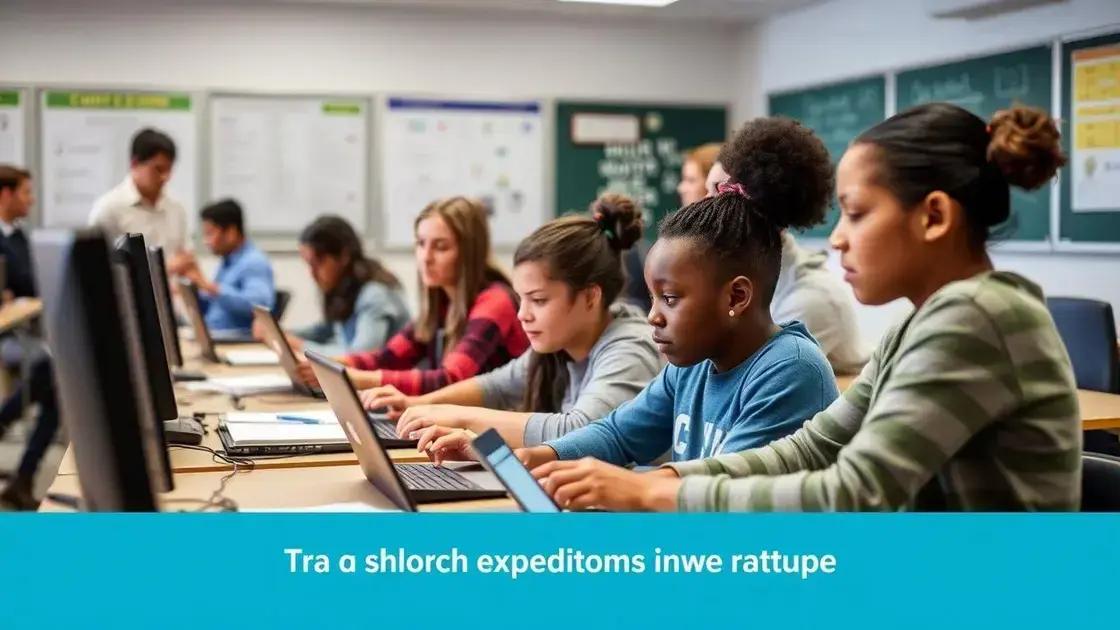Digital classroom tools that transform learning

Anúncios
Digital classroom tools enhance student engagement, provide personalized learning experiences, and improve accessibility, making them essential for modern education.
When we talk about improving education, digital classroom tools come to mind as game changers. They not only make learning exciting but also foster better engagement between students and teachers. Curious about how these tools can reshape your classroom experience?
Anúncios
Understanding the importance of digital classroom tools
Understanding the importance of digital classroom tools is crucial for modern education. These tools enhance the learning experience by making it interactive and engaging.
Enhancing Engagement
One of the biggest advantages of using digital tools is the increase in student engagement. When students have access to technology, they are often more motivated to participate in lessons. This shift not only makes learning more enjoyable but also fosters better retention of information.
Anúncios
Facilitating Collaboration
Digital classroom tools allow for collaboration among students. Many platforms offer shared spaces where learners can work together on projects in real time. This builds teamwork skills and prepares students for future careers.
- Real-time editing and sharing of documents
- Interactive presentations
- Discussion boards for collaborative learning
Moreover, these tools can cater to different learning styles. Some students may benefit from visual aids, while others might prefer hands-on activities. Offering a range of digital resources can help meet the diverse needs of every student in the classroom.
Improving Accessibility
Accessibility is another key reason to implement digital classroom tools. Students who have disabilities can benefit from technology that provides customized solutions to support their learning. Options like text-to-speech and various assistive devices help ensure that all students have equal opportunities to succeed in their education.
Ultimately, by understanding the importance of digital classroom tools, educators can create an inclusive and effective learning environment. These innovations are not just trends; they are essential for preparing students for the future.
Top digital classroom tools for effective teaching
Choosing the right digital classroom tools is essential for effective teaching. With technology evolving quickly, teachers have access to a variety of resources that can enhance their classroom experience.
Interactive Learning Platforms
These platforms offer exciting ways for students to engage with educational content. Tools like Google Classroom and Edmodo are popular for managing assignments and fostering communication between teachers and students.
- Easy assignment distribution
- Real-time feedback on projects
- Communication forums for discussion
Teachers can create a more organized system that helps keep everyone on track. With these platforms, students can participate more actively in their learning.
Adaptive Learning Technologies
Another important category includes tools that adapt to individual student needs, such as Khan Academy and IXL. These programs assess student performance and adjust the difficulty of tasks accordingly.
Using adaptive tools helps ensure that every student learns at a pace that suits them. This personalized approach can lead to better outcomes and increased motivation.
In addition to these tools, applications for collaborative projects like Padlet or Microsoft Teams allow students to work together seamlessly, regardless of their location. Here, they can share resources, brainstorm ideas, and communicate effectively with one another.
Assessment Tools
Tools like Quizizz and Kahoot! are excellent for quick assessments. They make testing fun and interactive, providing instant feedback that helps students learn from their mistakes.
Such dynamic solutions keep students engaged and encourage healthy competition. Incorporating these digital assessments can lead to improved student performance and understanding of the material.
How to integrate digital tools into your curriculum

Integrating digital tools into your curriculum can greatly enhance the learning experience for students. Effective integration requires careful planning and a clear understanding of the tools available.
Assessing Educational Needs
The first step in this process is to assess the specific needs of your students. What are their learning styles? What subjects require more engagement? Having a clear picture allows you to choose the right digital tools for your classroom.
- Identify areas where students struggle
- Evaluate the current curriculum
- Consider student feedback on learning experiences
Once you understand the needs, you can find tools that align with your curriculum objectives. For instance, if students need help with math, tools like IXL or Khan Academy can provide personalized practice.
Training and Support
Providing training for both teachers and students is essential for effective integration. Some teachers might need guidance on using new technologies, while students should understand how these tools can support their learning journeys.
Encouraging professional development can boost confidence among teachers. Meanwhile, students should receive tutorials to ensure they can navigate the tools seamlessly. This creates a positive environment where technology enhances education.
In addition, incorporating regular feedback sessions can help teachers adjust their approaches, making the integration process smoother. This ongoing dialogue fosters a supportive learning environment.
Benefits of using digital tools in education
Using digital tools in education provides numerous benefits that enhance the learning process. Students can gain access to a wealth of information and resources right at their fingertips.
Enhanced Engagement
One major advantage is the increased engagement students experience. Digital tools often include interactive elements that make learning more enjoyable. For example, using gamified learning apps can motivate students to participate actively in their education.
- Interactive quizzes and games that make learning fun
- Visual aids that cater to different learning styles
- Opportunities for students to collaborate on projects
This active participation fosters a love for learning and encourages students to explore subjects beyond the classroom.
Personalized Learning
Digital tools also allow for personalized learning experiences. Students can progress at their own pace, accessing resources that match their individual needs. Platforms like DreamBox and Khan Academy provide tailored lessons that adapt to the student’s performance.
This means that students can focus on areas they find challenging, while also advancing in topics they grasp quickly. Personalized assessments provide valuable insights into each student’s progress.
Increased Accessibility
Another important benefit is the increased accessibility to educational materials. Students can access content from anywhere, whether they’re at home or on the go. This flexibility ensures that all students have the opportunity to engage with their studies.
Using tools like Google Drive or OneNote, students can collaborate on projects and share ideas easily. This promotes teamwork and communication skills, which are vital in today’s world.
Challenges and tips for adopting digital classroom tools
Adopting digital classroom tools can come with challenges that educators must navigate carefully. It’s important to be aware of these obstacles to make the transition smoother.
Common Challenges
One of the primary challenges is the resistance to change. Some educators may be hesitant to integrate new technologies into their teaching practices, fearing it will complicate their current methods.
- Lack of confidence in using technology
- Concerns about student distractions
- Difficulty in accessing reliable internet
Another issue could be a lack of proper training. Without adequate support or professional development, teachers might struggle to use these tools effectively.
Tips for Successful Integration
To overcome these challenges, educators can take several steps. Firstly, providing strong training programs can help build confidence and skills. Offering workshops or online courses can be beneficial for teachers to familiarize themselves with various tools.
It’s also essential to involve students in the process. By encouraging them to explore digital tools, educators can turn potential distractions into valuable learning opportunities. Setting clear guidelines for use can minimize issues related to focus.
A support network among teachers can also make a difference. Sharing experiences and best practices creates a collaborative environment that fosters growth and innovation. Regular feedback from both students and teachers can help refine digital tool usage.
In conclusion, adopting digital classroom tools can greatly enhance the learning experience for both teachers and students. While challenges may arise during the integration process, understanding these obstacles allows educators to be better prepared. By providing necessary training and fostering a collaborative environment, schools can create a more engaging and effective learning atmosphere. Overall, with the right approach, digital tools can lead to improved educational outcomes and prepare students for the future.
FAQ – Frequently Asked Questions about Digital Classroom Tools
What are some benefits of using digital classroom tools?
Digital classroom tools enhance engagement, provide personalized learning experiences, and improve accessibility for all students.
How can teachers get trained to use these digital tools?
Professional development workshops, online courses, and peer mentoring can help educators gain the skills they need to effectively use digital tools in their classrooms.
What challenges might schools face when adopting digital tools?
Common challenges include resistance to change, lack of adequate training, and concerns over student distractions.
How can students benefit from using digital tools in their education?
Students can enjoy a more interactive learning environment, access resources anytime and anywhere, and develop essential collaboration skills.






